Liquid Crystalline Mixtures with Induced Polymorphic Smectic Phases Targeted for Energy Investigations
Abstract
1. Introduction
2. Results and Discussion
2.1. Mesomorphic and Binary Phase Mixture Investigations
2.1.1. Binary Mesophase Thermal Behavior of I6/I8 Derivatives
2.1.2. Binary Mesophase Thermal Behavior of I6/I16 Derivatives
2.1.3. Binary Mesophase Thermal Behavior of I8/I16 Derivatives
2.2. Absorbance Spectra
2.3. Experimental
2.4. Instrumentation
3. Conclusions
Supplementary Materials
Author Contributions
Funding
Data Availability Statement
Conflicts of Interest
References
- Veerabhadraswamy, B.N.; Rao, D.S.S.; Yelamaggad, C.V. Ferroelectric Liquid Crystals: Synthesis and Thermal Behavior of Optically Active, Three-Ring Schiff Bases and Salicylaldimines. Chem. Asian J. 2018, 13, 1012–1023. [Google Scholar] [CrossRef] [PubMed]
- Huang, C.-C.; Hsu, C.-C.; Chen, L.-W.; Cheng, Y.-L. The effect of position of (S)-2-octyloxy tail on the formation of frustrated blue phase and antiferroelectric phase in Schiff base liquid crystals. Soft Matter 2014, 10, 9343–9351. [Google Scholar] [CrossRef] [PubMed]
- Segura, J.L.; Mancheño, M.J.; Zamora, F. Covalent organic frameworks based on Schiff-base chemistry: Synthesis, properties and potential applications. Chem. Soc. Rev. 2016, 45, 5635–5671. [Google Scholar] [CrossRef] [PubMed]
- Gowda, A.; Jacob, L.; Joy, N.; Philip, R.; Pratibha, R.; Kumar, S. Thermal and nonlinear optical studies of newly synthesized EDOT based bent-core and hockey-stick like liquid crystals. New J. Chem. 2018, 42, 2047–2057. [Google Scholar] [CrossRef]
- Hagar, M.; Ahmed, H.A.; Saad, G.R. Mesophase stability of new Schiff base ester liquid crystals with different polar substituents. Liq. Cryst. 2018, 45, 1324–1332. [Google Scholar] [CrossRef]
- Alamro, F.S.; Gomha, S.M.; Shaban, M.; Altowyan, A.S.; Abolibda, T.Z.; Ahmed, H.A. Optical investigations and photoactive solar energy applications of new synthesized Schiff base liquid crystal derivatives. Sci. Rep. 2021, 11, 15046. [Google Scholar] [CrossRef]
- Gomha, S.; Ahmed, H.; Shaban, M.; Abolibda, T.; Khushaim, M.; Alharbi, K. Synthesis, Optical Characterizations and Solar Energy Applications of New Schiff Base Materials. Materials 2021, 14, 3718. [Google Scholar] [CrossRef]
- Al-Mutabagani, L.A.; Alshabanah, L.A.; Gomha, S.M.; Abolibda, T.Z.; Shaban, M.; Ahmed, H.A. Synthesis and Mesomorphic and Electrical Investigations of New Furan Liquid Crystal Derivatives. Front. Chem. 2021, 9, 711862. [Google Scholar] [CrossRef]
- Khan, M.T. Unraveling the impact of graphene nanostructures passivation on the electrical properties of the perovskite solar cell. Mater. Sci. Semicond. Process. 2023, 153, 107172. [Google Scholar] [CrossRef]
- Alamro, F.S.; Ahmed, H.A.; Gomha, S.M.; Shaban, M. Synthesis, Mesomorphic, and Solar Energy Characterizations of New Non-Symmetrical Schiff Base Systems. Front. Chem. 2021, 9, 686788. [Google Scholar] [CrossRef]
- Georgiev, A.; Stoilova, A.; Dimov, D.; Yordanov, D.; Zhivkov, I.; Weiter, M. Synthesis and photochromic properties of some N-phthalimide azo-azomethine dyes. A DFT quantum mechanical calculations on imine-enamine tautomerism and trans-cis photoisomerization. Spectrochim. Acta Part A Mol. Biomol. Spectrosc. 2019, 210, 230–244. [Google Scholar] [CrossRef] [PubMed]
- Ovdenko, V.; Kolendo, A. New bent-shaped azomethine monomers for optical applications. Mol. Cryst. Liq. Cryst. 2016, 640, 113–121. [Google Scholar] [CrossRef]
- Komissarova, O.A.; Lukyanov, B.S.; Lukyanova, M.B.; Ozhogin, I.V.; Mukhanov, E.L.; Korobov, M.S.; Rostovtseva, I.A.; Minkin, V.I. New indoline spiropyrans containing azomethine fragment. Russ. Chem. Bull. 2017, 66, 2122–2125. [Google Scholar] [CrossRef]
- Stoilova, A.; Georgiev, A.; Nedelchev, L.; Nazarova, D.; Dimov, D. Structure-property relationship and photoinduced birefringence of the azo and azo-azomethine dyes thin films in PMMA matrix. Opt. Mater. 2019, 87, 16–23. [Google Scholar] [CrossRef]
- Georgiev, A.; Kostadinov, A.; Ivanov, D.; Dimov, D.; Stoyanov, S.; Nedelchev, L.; Nazarova, D.; Yancheva, D. Synthesis, spectroscopic and TD-DFT quantum mechanical study of azo-azomethine dyes. A laser induced trans-cis-trans photoisomerization cycle. Spectrochim. Acta Part A Mol. Biomol. Spectrosc. 2018, 192, 263–274. [Google Scholar] [CrossRef]
- Reddy, D.S.; Reddy, G.S.; Beatriz, A.; Corey, E.J. Contrasting Diastereoselectivity between Cyclic Nitrones and Azomethine Ylides. Stereocontrolled Pathways to cis-anti-anti-cis-Oxazatetraquinanes from a Bicyclic Nitrone. Org. Lett. 2021, 23, 5445–5447. [Google Scholar] [CrossRef]
- Ruslim, C.; Ichimura, K.J. Z-Isomers of 3,3′-disubstituted azobenzenes highly compatible with liquid crystals. Mater. Chem. 1999, 9, 673–681. [Google Scholar] [CrossRef]
- Ichimura, K. Photoalignment of Liquid-Crystal Systems. Chem. Rev. 2000, 100, 1847–1874. [Google Scholar] [CrossRef]
- Ikeda, T. Photomodulation of liquid crystal orientations for photonic applications. J. Mater. Chem. 2003, 13, 2037–2057. [Google Scholar] [CrossRef]
- Naoum, M.M.; Fahmi, A.A.; Alaasar, M.A. Supramolecular Hydrogen-Bonded Liquid Crystals Formed from 4-(4′-Pyridylazophenyl)-4″-alkoxy Benzoates and 4-Substituted Benzoic Acids. Mol. Cryst. Liq. Cryst. 2008, 487, 74–91. [Google Scholar] [CrossRef]
- Blatch, A.E.; Luckhurst, G.R. The liquid crystal properties of symmetric and non-symmetric dimmers based on the azobenzene mesogenic group. Liq Cryst. 2000, 27, 775–787. [Google Scholar] [CrossRef]
- Thaker, B.; Kanojiya, J. Mesomorphic properties of liquid crystalline compounds with biphenyl moiety containing azo-ester, azo-cinnamate central linkages and different terminal group. Liq. Cryst. 2011, 38, 1035–1055. [Google Scholar] [CrossRef]
- Alaasar, M. Azobenzene-containing bent-core liquid crystals: An overview. Liq. Cryst. 2016, 43, 2208–2243. [Google Scholar] [CrossRef]
- Niezgoda, I.; Jaworska, J.; Pociecha, D.; Galewski, Z. The kinetics of the E-Z-E isomerisation and liquid-crystalline properties of selected azobenzene derivatives investigated by the prism of the ester group inversion. Liq. Cryst. 2015, 42, 1148–1158. [Google Scholar] [CrossRef]
- Hegde, G.; Shanker, G.; Gan, S.M.; Yuvaraj, A.R.; Mahmood, S.; Mandal, U.K. Synthesis and liquid crystalline behaviour of substituted (E)-phenyl-4-(phenyldiazenyl) benzoate derivatives and their photo switching ability. Liq. Cryst. 2016, 43, 1578–1588. [Google Scholar] [CrossRef]
- Paterson, D.A.; Xiang, J.; Singh, G.; Walker, R.; Agra-Kooijman, D.M.; Martinez-Felipe, A.; Gan, M.; Storey, J.M.D.; Kumar, S.; Lavrentovich, O.D.; et al. Reversible Isothermal Twist-Bend Nematic-Nematic Phase Transition Driven by the Photoisomerization of an Azobenzene-Based Nonsymmetric Liquid Crystal Dinner. J. Am. Chem. Soc. 2016, 138, 5283–5289. [Google Scholar] [CrossRef]
- Romero-Hasler, P.; Fierro-Armijo, A.E.; Soto-Bustamante, E.A.; Meneses-Franco, A. Synthesis and characterisation of two homologous series of LC acrylic monomers based on phenolic and resorcinic azobenzene groups. Liq. Cryst. 2016, 43, 1804–1812. [Google Scholar] [CrossRef]
- Henderson, P.; Cook, A.; Imrie, C. Oligomeric liquid crystals: From monomers to trimers. Liq. Cryst. 2004, 31, 1427–1434. [Google Scholar] [CrossRef]
- Osman, F.; Yeap, G.-Y.; Nagashima, A.; Ito, M.M. Structure property and mesomorphic behaviour of S-shaped liquid crystal oligomers possessing two azobenzene moieties. Liq. Cryst. 2016, 43, 1283–1292. [Google Scholar] [CrossRef]
- Srinivasa, H.T. New symmetric azobenzene molecules of varied central cores: Synthesis and characterisation for liquid crystalline properties. Liq. Cryst. 2017, 44, 1384–1393. [Google Scholar] [CrossRef]
- Rochon, P.; Batalla, E.; Natansohn, A. Optically induced surface gratings on azoaromatic polymer films. Appl. Phys. Lett. 1995, 66, 136–138. [Google Scholar] [CrossRef]
- Wang, M.; Guo, L.X.; Lin, B.P.; Zhang, X.Q.; Sun, Y.; Yang, H. Photo-responsive polysiloxane-based azobenzene liquid crystalline polymers prepared by thiol-ene click chemistry. Liq. Cryst. 2016, 43, 1626–1635. [Google Scholar] [CrossRef]
- Goodby; Mandle; Davis; Zhong; Cowling What makes a liquid crystal? The effect of free volume on soft matter. Liq. Cryst. 2015, 42, 593–622. [CrossRef]
- Hagar, M.; Ahmed, H.; Saad, G. Synthesis and mesophase behaviour of Schiff base/ester 4-(arylideneamino)phenyl-4″-alkoxy benzoates and their binary mixtures. J. Mol. Liq. 2019, 273, 266–273. [Google Scholar] [CrossRef]
- Ahmed, H.A.; Hagar, M.; Saad, G. Impact of the proportionation of dialkoxy chain length on the mesophase behaviour of Schiff base/ester liquid crystals; experimental and theoretical study. Liq. Cryst. 2019, 46, 1611–1620. [Google Scholar] [CrossRef]
- Hagar, M.; Ahmed, H.A.; Alhaddad, O.A. New azobenzene-based natural fatty acid liquid crystals with low melting point: Synthesis, DFT calculations and binary mixtures. Liq. Cryst. 2019, 46, 2223–2234. [Google Scholar] [CrossRef]
- Hagar, M.; Ahmed, H.; Saad, G. New calamitic thermotropic liquid crystals of 2-hydroxypyridine ester mesogenic core: Mesophase behaviour and DFT calculations. Liq. Cryst. 2019, 47, 114–124. [Google Scholar] [CrossRef]
- Ahmed, H.A.; Hagar, M.; Alaasar, M.; Naoum, M. Wide nematic phases induced by hydrogen-bonding. Liq. Cryst. 2019, 46, 550–559. [Google Scholar] [CrossRef]
- Ahmed, H.; Hagar, M.; Alhaddad, O. Mesomorphic and geometrical orientation study of the relative position of fluorine atom in some thermotropic liquid crystal systems. Liq. Cryst. 2019, 47, 404–413. [Google Scholar] [CrossRef]
- Ahmed, H.A.; Hagar, M.; El-Sayed, T.H.; Alnoman, R.B. Schiff base/ester liquid crystals with different lateral substituents: Mesophase behaviour and DFT calculations. Liq. Cryst. 2019, 46, 1–11. [Google Scholar] [CrossRef]
- Omar, A.Z.; El-Atawy, M.A.; Alsubaie, M.S.; Alazmi, M.L.; Ahmed, H.A.; Hamed, E.A. Synthesis and Computational Investigations of New Thioether/Azomethine Liquid Crystal Derivatives. Crystals 2023, 13, 378. [Google Scholar] [CrossRef]
- Ahmed, H.A.; Hagar, M.; Alhaddad, O.A. New chair shaped supramolecular complexes-based aryl nicotinate derivative; mesomorphic properties and DFT molecular geometry. RSC Adv. 2019, 9, 16366–16374. [Google Scholar] [CrossRef] [PubMed]
- Nafee, S.S.; Hagar, M.; Ahmed, H.A.; Alhaddad, O.; El-Shishtawy, R.M.; Raffah, B.M. New two rings Schiff base liquid crystals; ball mill synthesis, mesomorphic, Hammett and DFT studies. J. Mol. Liq. 2019, 299, 112161. [Google Scholar] [CrossRef]
- Al-Zahrani, S.A.; Khan, M.T.; Jevtovic’, V.; Masood, N.; Jeilani, Y.A.; Ahmed, H.A. Design of Liquid Crystal Materials Based on Palmitate, Oleate, and Linoleate Derivatives for Optoelectronic Applications. Molecules 2023, 28, 1744. [Google Scholar] [CrossRef] [PubMed]
- Alhaddad, O.A.; Khushaim, M.S.; Gomha, S.M.; Ahmed, H.A.; Naoum, M.M. Mesophase behavior of four ring ester/azomethine/ester liquid crystals in pure and mixed states. Liq. Cryst. 2022, 49, 1395–1402. [Google Scholar] [CrossRef]
- O’Neill, M.; Kelly, S. Liquid Crystals for Charge Transport, Luminescence, and Photonics. Adv. Mater. 2003, 15, 1135–1146. [Google Scholar] [CrossRef]
- Andrienko, D. Introduction to liquid crystals. J. Mol. Liq. 2018, 267, 520–541. [Google Scholar] [CrossRef]
- Jaishi, B.R.; Mandal, P.K.; Dabrowski, R. Studies on binary mixtures of 4-pentyloxy-4′-cyanobiphenyl. Opto-Electron. Rev. 2010, 18, 111–120. [Google Scholar] [CrossRef]
- Manohar, R.; Srivastava, A.K.; Jyotishman, P.; Shukla, J.P.; Prajapati, A.K.; Bonde, N.L. Dielectric, optical and thermodynamical properties of liquid crystal sample exhibiting sm a phase. Int. J. Phys. Sci. 2006, 1, 147–153. [Google Scholar]
- Kim, N.; Huang, T.M.; Kyu, T.; Nosaka, M.; Kudo, H.; Nishikubo, T. Induced smectic phase in mixtures of hyper branch polyester and liquid crystal mesogens. J. Phys. Chem. 2008, 112, 13225–13230. [Google Scholar] [CrossRef]
- Govindaiah, T.; Sreepad, H. Phase transition and thermal characterization of induced smectic phases in a ternary mixture. J. Mol. Liq. 2015, 202, 75–78. [Google Scholar] [CrossRef]
- Diele, S.; Pelzl, G.; Weissflog, W.; Demus, D. A filled smectic A phase A novel kind of induced smectic A phase observed for binary mixtures. Liq. Cryst. 1988, 3, 1047–1053. [Google Scholar] [CrossRef]
- Sadowska, K.W.; Zywocinski, A.; Stecki, J.; Dabrowski, R. Induced smectic phases, densities of binary mixtures of 4, 4′-dialkylazoxybenzenes with 4-pentyl-4′- cyanobiphenyl (PCB). J. Phys. 1982, 43, 1673–1678. [Google Scholar] [CrossRef]
- Oh, C.S. Induced Smectic Mesomorphism by Incompatible Nematogens. Mol. Cryst. Liq. Cryst. 1977, 42, 1–14. [Google Scholar] [CrossRef]
- Hwang, J.C.; Kikuchi, H.; Kajiyama, T. Aggregation states and electro-optical properties of the induced smectic phase by mixing a nematic liquid crystalline polymer and a low molecular weight liquid crystal. Polymer 1992, 33, 1822–1825. [Google Scholar] [CrossRef]
- Naoum, M.M.; Fahmi, A.A.; Alaasar, M.A.; Abdel-Aziz, M.E. Effect of lateral substitution of different polarity on the mesophase behavior in pure and mixed states of 4-(4′-substituted phenylazo)-2-substituted phenyl-4′′-alkoxy benzoates. Liq. Cryst. 2011, 38, 391–405. [Google Scholar] [CrossRef]
- Alamro, F.S.; Tolan, D.A.; El-Nahas, A.M.; Ahmed, H.A.; El-Atawy, M.A.; Al-Kadhi, N.S.; Aziz, S.G.; Shibl, M.F. Wide Nematogenic Azomethine/Ester Liquid Crystals Based on New Biphenyl Derivatives: Mesomorphic and Computational Studies. Molecules 2022, 27, 4150. [Google Scholar] [CrossRef]
- Imrie, C. Non-symmetric liquid crystal dimers: How to make molecules intercalate. Liq. Cryst. 2006, 33, 1449–1485. [Google Scholar] [CrossRef]
- Ooi, Y.-H.; Yeap, G.-Y.; Han, C.-C.; Lin, H.-C.; Kubo, K.; Ito, M.M. Synthesis and smectogenic properties of novel phloroglucinol-based star-shaped liquid crystals containing three peripheral alkyloxylated Schiff base arms. Liq. Cryst. 2013, 40, 516–527. [Google Scholar] [CrossRef]
- Hinojosa, A.R.C.; de Souza, S.P.; Alves, T.V.; dos Santos, I.T.O.; Silva, E.O.; Gonçalves, I.L.; Merlo, A.A.; Junkes, C.F.; Bechtold, I.H.; Vieira, A.A. Shining rings: The effect of the rigid core and benzazole heterocycles on the properties of luminescent calamitic liquid crystals. J. Mol. Liq. 2021, 338, 116614. [Google Scholar] [CrossRef]
- Alamro, F.; Ahmed, H.; El-Atawy, M.; Al-Zahrani, S.; Omar, A. Induced Nematic Phase of New Synthesized Laterally Fluorinated Azo/Ester Derivatives. Molecules 2021, 26, 4546. [Google Scholar] [CrossRef] [PubMed]
- Alrefaee, S.H.; Ahmed, H.A.; Khan, M.T.; Al-Ola, K.A.; Al-Refai, H.; El-Atawy, M.A. New Self-Organizing Optical Materials and Induced Polymorphic Phases of Their Mixtures Targeted for Energy Investigations. Polymers 2022, 14, 456. [Google Scholar] [CrossRef]
- Ahmed, H.A. Thermal behavior of binary mixtures of isomers of different molecular structures and different lateral substituent positions. J. Therm. Anal. Calorim. 2016, 125, 823–830. [Google Scholar] [CrossRef]
- Abberley, J.P.; Jansze, S.M.; Walker, R.; Paterson, D.A.; Henderson, P.A.; Marcelis, A.T.M.; Storey, J.M.D.; Imrie, C.T. Structure–property relationships in twist-bend nematogens: The influence of terminal groups. Liq. Cryst. 2017, 44, 68–83. [Google Scholar] [CrossRef]
- Mohammady, S.Z.; Aldhayan, D.M.; Alshammri, M.A.; Alshammari, A.K.; Alazmi, M.; Katariya, K.D.; Jaremko, M.; Hagar, M. Polar Alkoxy Group and Pyridyl Effects on the Mesomorphic Behavior of New Non-Symmetrical Schiff Base Liquid Crystals. Symmetry 2021, 13, 1832. [Google Scholar] [CrossRef]
- Park, J.W.; Bak, C.S.; Labes, M.M. Effects of molecular complexing on the properties of binary nematic liquid crystal mixtures. J. Am. Chem. Soc. 1975, 97, 4398–4400. [Google Scholar] [CrossRef]
- Araya, K.; Matsunaga, Y. Liquid Crystal Formation in Binary Systems. I. An Interpretation of the Phase Diagrams of the Azoxydianisole–Schiff Base Systems. Bull. Chem. Soc. Jpn. 1980, 53, 989–993. [Google Scholar] [CrossRef]
- Dave, J.S.; Lohar, J.M. Liquid-crystalline characteristics of ester mesogens-para-chlorophenyl para’-normal-alkoxycinnamates. J. Indian Chem. Soc. 1989, 66, 25–27. [Google Scholar]
- Lohar, J.M.; Dave, J.S., Jr. Emergence of smectic mesophase in binary mixtures of pure nematogens. Mol. Cryst. Liq. Cryst. 1983, 103, 181–192. [Google Scholar] [CrossRef]
- Mlodziejowski, A. Dissoziation der flüssigen Kristalle. Z. Phys. Chem. 1928, 135, 129–146. [Google Scholar] [CrossRef]
- Gaubert, P. Nouvelle contribution à l’étude des sphérolites (polymorphisme de la codéine, de la thébaïne et de la narcotine). Bull. Minéral. 1913, 36, 45–64. [Google Scholar] [CrossRef]
- Kravchenko, V.M.; Pastukhova, I.S. Dvukhkomponentnye tverdye rastvory i evtekticheskie sistemy indena, izokhinolina, naftalina i benzola. Zhurnal Prikl. Khimii 1952, 25, 313–321. [Google Scholar]
- Dave, J.S.; Menon, M.R.; Patel, P.R. Synthesis and mesomorphic characteristics of mesogens with branched isoamyloxy and isobutyloxy terminal groups. Mol. Cryst. Liq. Cryst. 2002, 378, 1–11. [Google Scholar] [CrossRef]
- Schroeder, J.P.; Bristol, D.W. Liquid crystals. IV. Effects of terminal substituents on the nematic mesomorphism of p-phenylene dibenzoates. J. Org. Chem. 1973, 38, 3160–3164. [Google Scholar] [CrossRef]
- Park, J.W.; Labes, M.M. Broadening of the nematic temperature range by a non-mesogenic solute in a nematic liquid crystal. Mol. Cryst. Liq. Cryst. 1976, 34, 147–152. [Google Scholar] [CrossRef]
- El-Atawy, M.A.; Omar, A.Z.; Alazmi, M.L.; Alsubaie, M.S.; Hamed, E.A.; Ahmed, H.A. Synthesis and characterization of new imine liquid crystals based on terminal perfluoroalkyl group. Heliyon 2023, 9, e14871. [Google Scholar] [CrossRef]
- Saad, G.R.; Nessim, R.I. Effect of molecular structure on the phase behaviour of some liquid crystalline compounds and their binary mixtures VI [1]. The effect of molecular length. Liq. Cryst. 1999, 26, 629–636. [Google Scholar] [CrossRef]
- Cigl, M.; Hampl, F.; Svoboda, J.; Podoliak, N.; Stulov, S.; Kohout, M.; Novotná, V. Laterally substituted biphenyl benzoates—Synthesis and mesomorphic properties. Liq. Cryst. 2021, 48, 526–536. [Google Scholar] [CrossRef]
- Zhu, S.; Chigan, J.; Li, W.; Yang, J.; Chen, W.; Zhang, W.; Niu, X.; Chen, X.; An, Z.J. The effect of intermolecular actions on the mesomorphic properties of alkenoxy biphenyl-based liquid crystals. j. Mol. Liq. 2019, 296, 111880. [Google Scholar] [CrossRef]
- Yang, R.; Chen, L.; Ruan, C.; Zhong, H.-Y.; Wang, Y.-Z. Chain folding in main-chain liquid crystalline polyesters: From π–π stacking toward shape memory. J. Mater. Chem. C 2014, 2, 6155. [Google Scholar] [CrossRef]
- Liu, G.-F.; Ye, B.-H.; Ling, Y.-H.; Chen, X.-M. Interlocking of molecular rhombi into a 2D polyrotaxane network via π–π interactions. Crystal structure of [Cu 2 (bpa) 2 (phen) 2 (H 2 O)] 2· 2H 2 O (bpa 2−= biphenyl-4, 4′-dicarboxylate, phen= 1, 10-phenanthroline). Chem. Commun. 2002, 14, 1442. [Google Scholar] [CrossRef] [PubMed]
- Pellequer, J.-L.; Chen, S.W.; Keum, Y.; Karu, A.E.; Li, Q.X.; Roberts, V.A. Structural basis for preferential binding of non-ortho-substituted polychlorinated biphenyls by the monoclonal antibody S2B1. J. Mol. Recognit. 2005, 18, 282. [Google Scholar] [CrossRef] [PubMed]
- Petriello, M.C.; Newsome, B.J.; Dziubla, T.D.; Hilt, J.Z.; Bhattacharyya, D.; Hennig, B. Modulation of persistent organic pollutant toxicity through nutritional intervention: Emerging opportunities in biomedicine and environmental remediation. Sci. Total Environ. 2014, 491–492, 11–16. [Google Scholar] [CrossRef] [PubMed]
- Jacquemin, D.; Laurent, A.D.; Perpète, E.A.; André, J.-M. An ab initio simulation of the UV/visible spectra of N -benzylideneaniline dyes. Int. J. Quantum Chem. 2009, 109, 3506–3515. [Google Scholar] [CrossRef]
- Nozomu, E.; Benzylideneaniline, I. Structure and Ultraviolet Absorption Spectrum of Benzylideneaniline. Bull. Chem. Soc. Jpn. 1960, 33, 534–539. [Google Scholar]
- Khan, M.T.; Almohammedi, A.; Shkir, M.; Aboud, S.W. Effect of Ag2S nanoparticles on optical, photophysical and electrical properties of P3HT thin films. Luminescence 2021, 36, 761–768. [Google Scholar] [CrossRef]
- Almohammedi, A.; Khan, M.T.; Benghanem, M.; Aboud, S.W.; Shkir, M.; AlFaify, S. Elucidating the impact of PbI2 on photophysical and electrical properties of poly(3-hexythiophene). Mater. Sci. Semicond. Process. 2020, 120, 105272. [Google Scholar] [CrossRef]
- Khan, M.T.; Shkir, M.; Yahia, I.S.; Almohammedi, A.; AlFaify, S. An impact of Cr-doping on physical properties of PbI2 thin films facilely deposited by spin coating technique. Superlattices Microstruct. 2020, 138, 106370. [Google Scholar] [CrossRef]
- Khan, M.T.; Shkir, M.; Alhouri, B.; Almohammedi, A.; Ismail, Y.A. Modulation of optical, photophysical and electrical properties of poly(3-hexylthiophene) via Gd:CdS nanoparticles. Optik 2022, 260, 169092. [Google Scholar] [CrossRef]
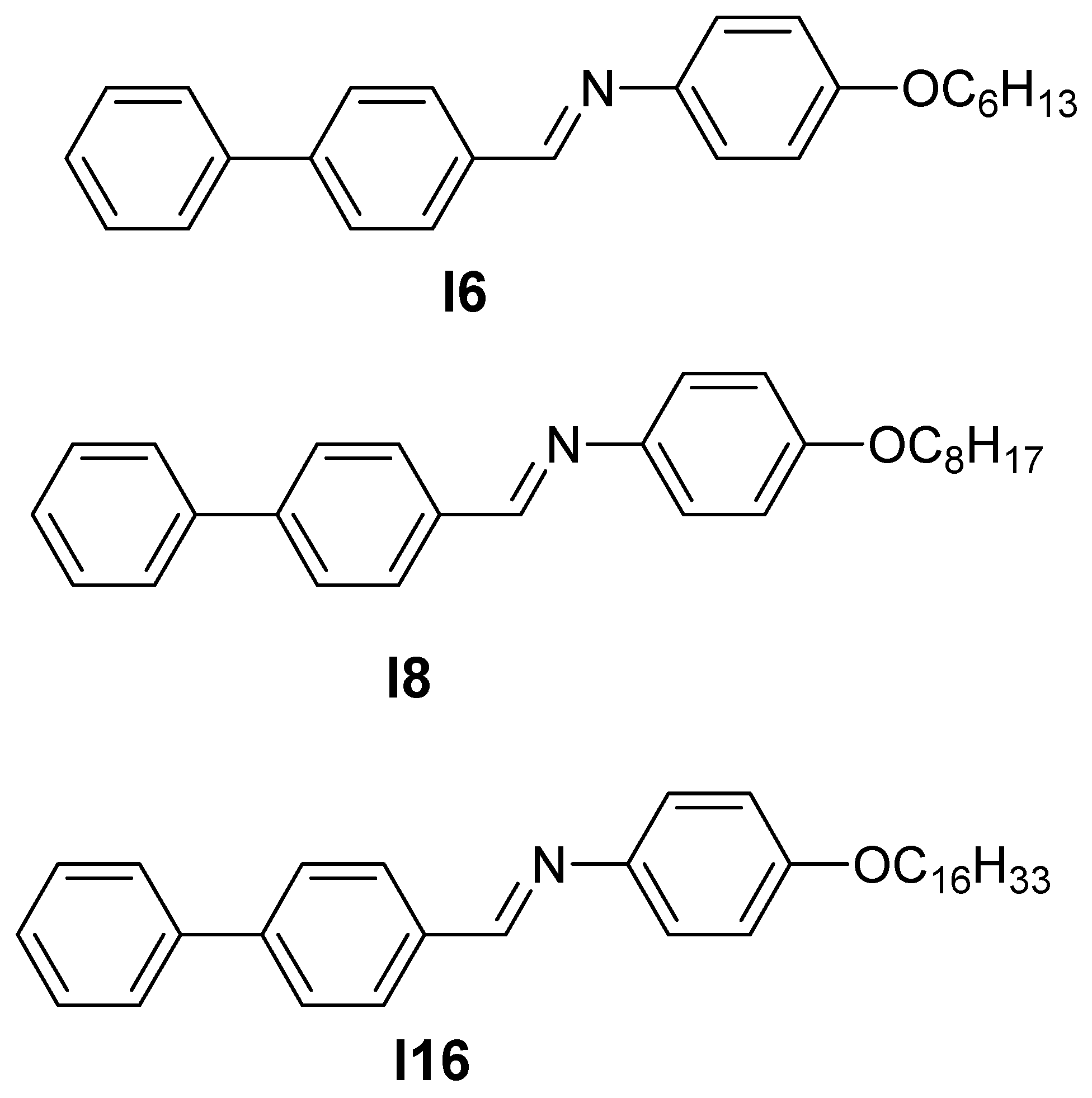
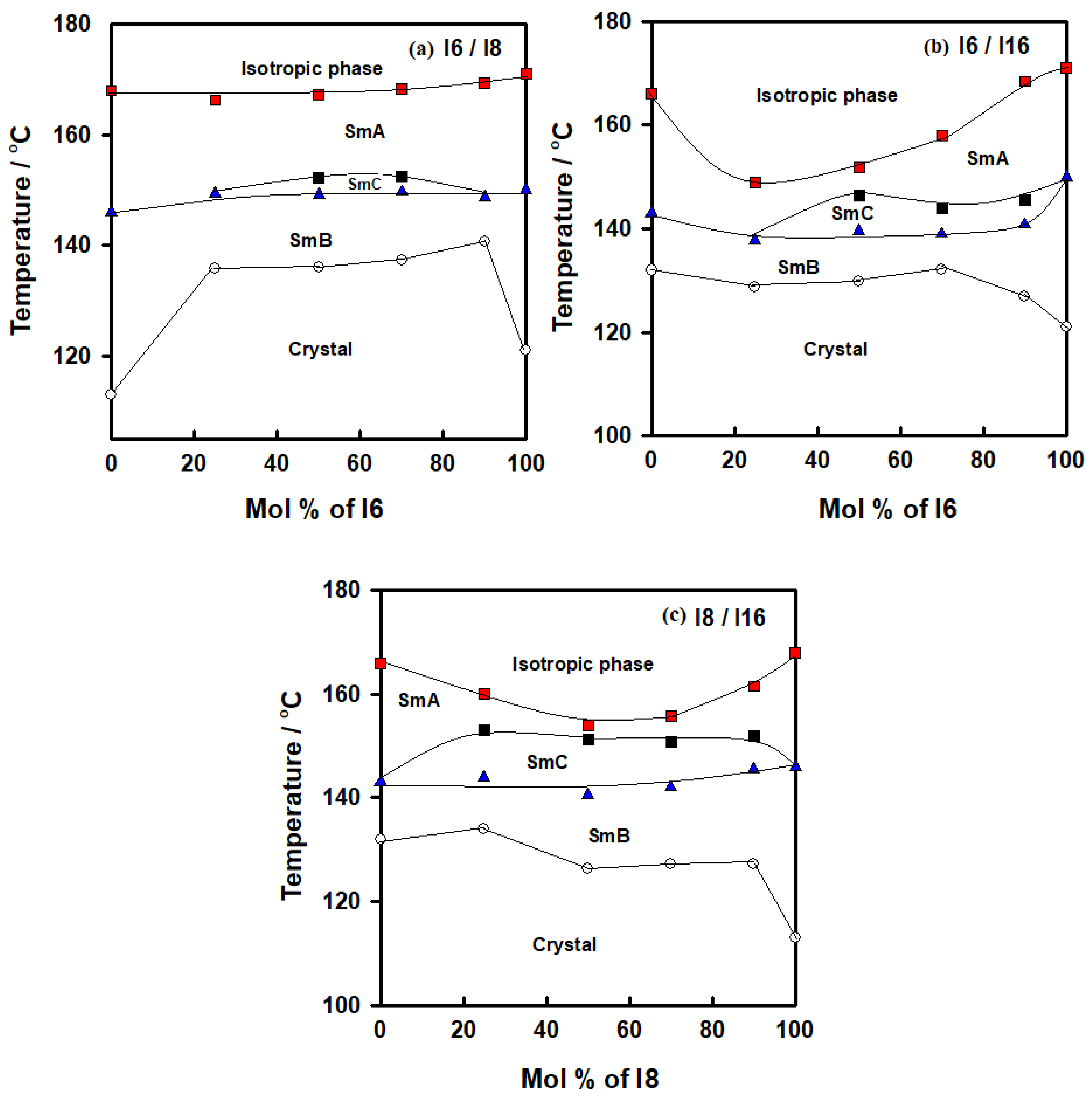


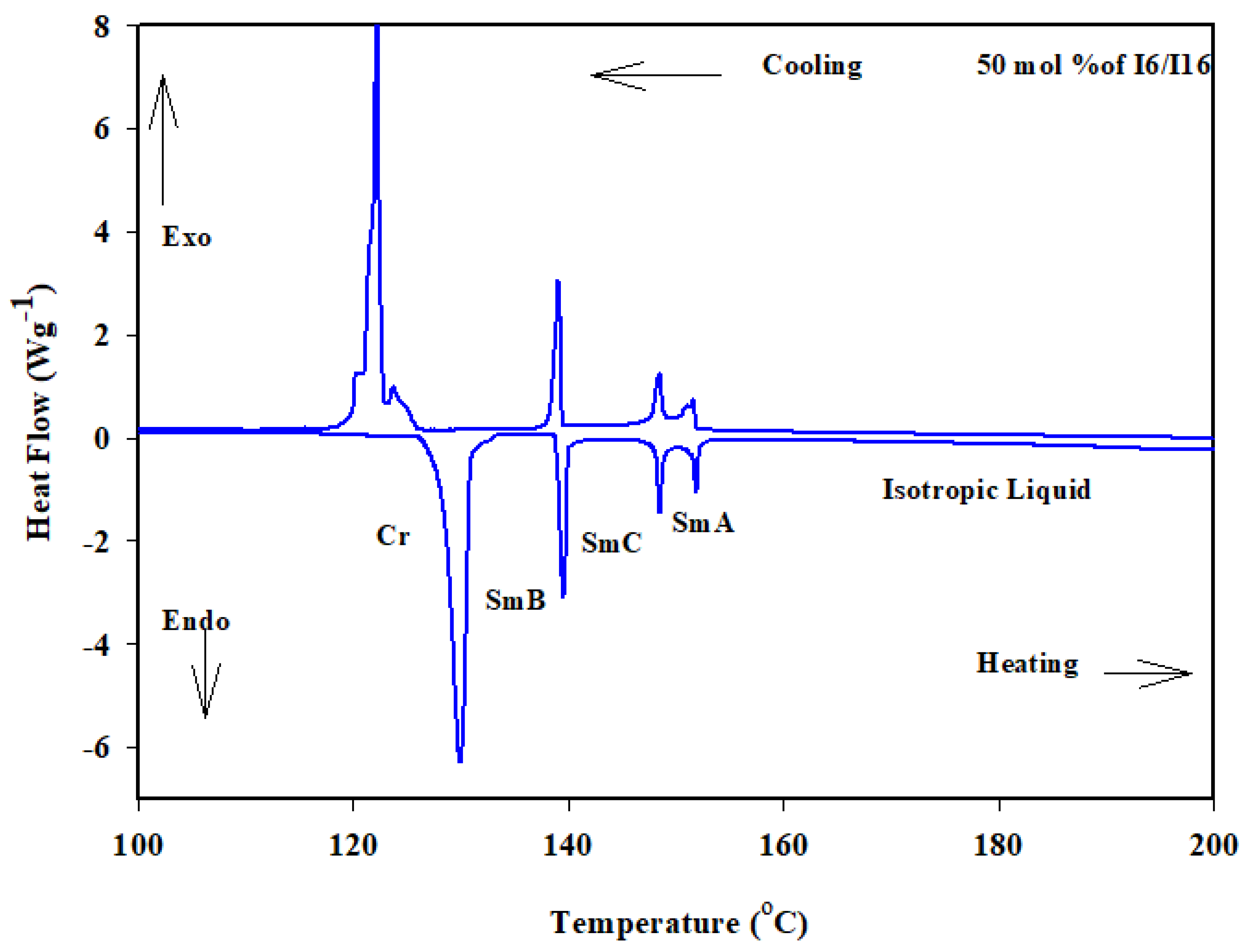
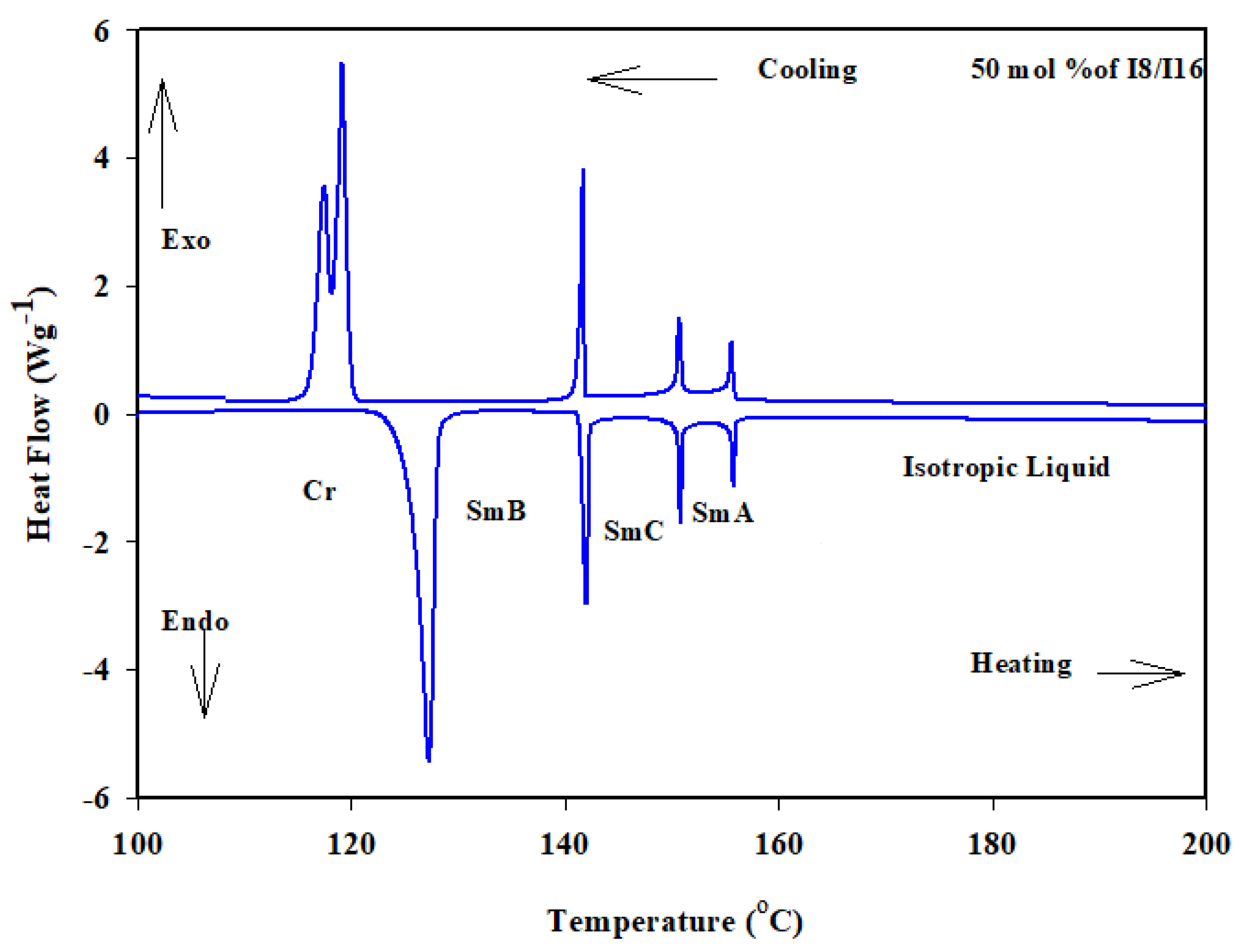

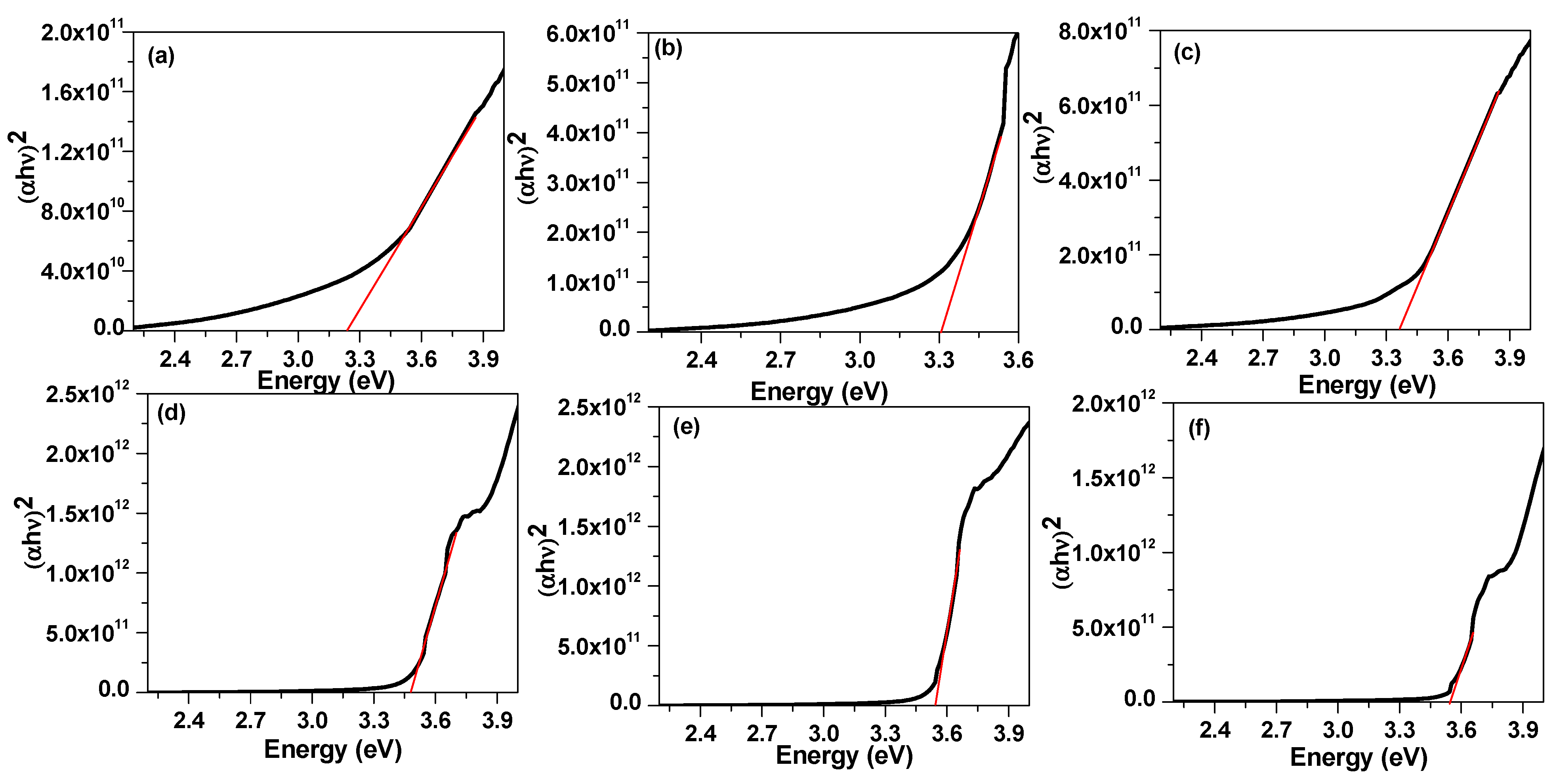
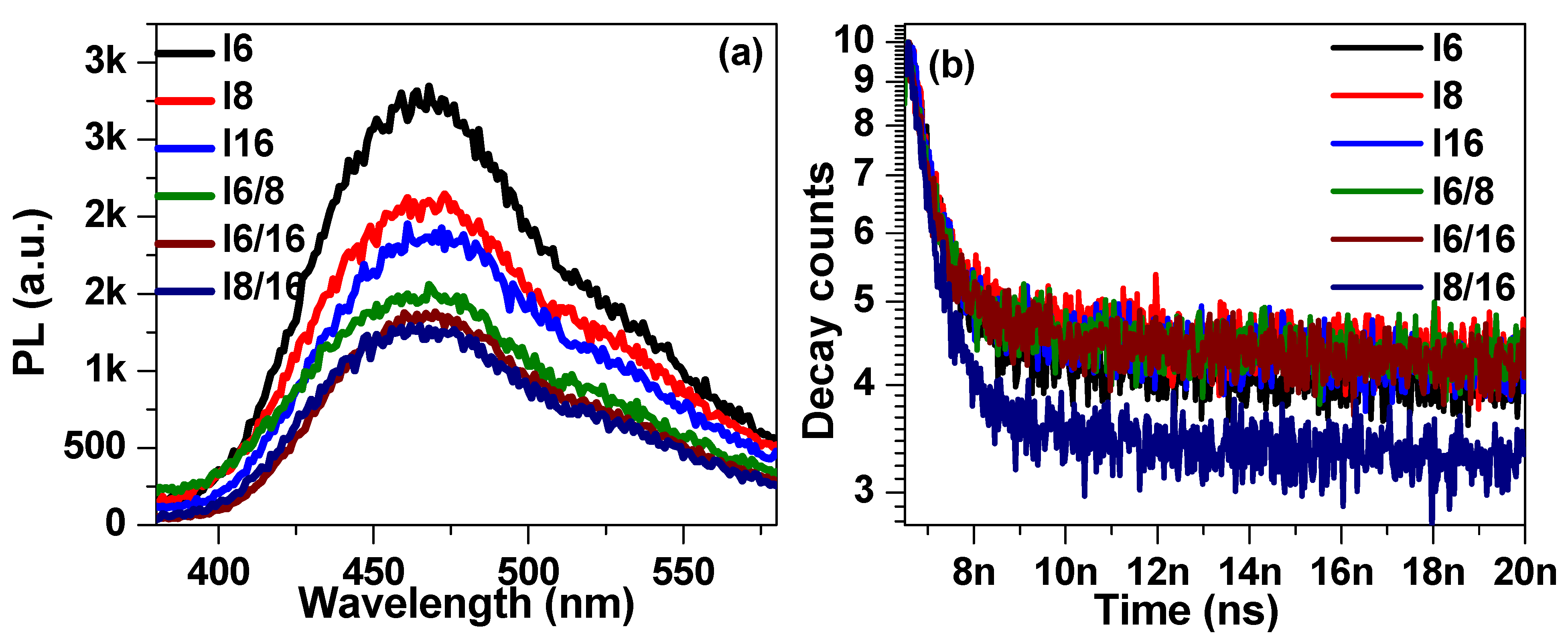
| % Compound (System I6/I8) | TCr–SmB | ΔHCr–SmB | TSmB–SmC | ΔHSmB–SmC | TSmC–SmA | ΔHSmC–SmA | TSmA–I | ΔHSmA–I |
| 0% I6 | 113.0 | 51.78 | 146.0 | 28.11 | - | - | 168.0 | 3.22 |
| 24% I6 | 135.9 | 49.27 | 149.3 | 23.22 | - | - | 166.3 | 3.27 |
| 50% I6 | 136.0 | 43.62 | 149.1 | 30.25 | 152.3 | 4.21 | 167.2 | 3.18 |
| 75% I6 | 137.3 | 50.29 | 149.7 | 27.21 | 152.4 | 4.36 | 168.4 | 3.12 |
| 90% I6 | 140.7 | 46.20 | 148.8 | 21.72 | - | - | 169.4 | 3.00 |
| 100% I6 | 121.0 | 51.00 | 150.0 | 25.84 | - | - | 171.0 | 3.92 |
| %Compound (System I6/I16) | TCr–SmB | ΔHCr–SmB | TSmB–SmC | ΔHSmB–SmC | TSmC–SmA | ΔHSmC–SmA | TSmA–I | ΔHSmA–I |
| 0% I6 | 132.0 | 31.50 | 143.0 | 29.91 | - | - | 166.0 | 3.00 |
| 25% I6 | 128.7 | 39.20 | 137.8 | 33.92 | - | - | 148.9 | 3.95 |
| 50% I6 | 129.9 | 43.67 | 139.6 | 30.20 | 146.5 | 3.82 | 151.9 | 2.19 |
| 74% I6 | 132.2 | 46.21 | 139.0 | 28.29 | 144.0 | 3.99 | 157.9 | 2.96 |
| 90% I6 | 127.0 | 40.25 | 140.8 | 31.88 | 145.6 | 3.89 | 168.4 | 3.10 |
| 100% I6 | 121.0 | 41.40 | 150.0 | 35.44 | - | - | 171.0 | 3.72 |
| %Compound (System I8/I16) | TCr–SmB | ΔHCr–SmB | TSmB–SmC | ΔHSmB–SmC | TSmC–SmA | ΔHSmC–SmA | TSmA–I | ΔHSmA–I |
| 0% I8 | 132.0 | 44.52 | 143.0 | 37.11 | 166.0 | 3.29 | ||
| 25% I8 | 134.0 | 39.10 | 144.0 | 32.78 | 153.0 | 4.00 | 160.0 | 3.66 |
| 50% I8 | 126.4 | 37.50 | 140.6 | 25.90 | 151.2 | 3.36 | 154.0 | 3.10 |
| 75% I8 | 127.3 | 46.00 | 142.0 | 29.09 | 150.8 | 3.71 | 155.8 | 3.02 |
| 90% I8 | 127.3 | 42.27 | 145.5 | 30.80 | 151.9 | 4.16 | 161.5 | 3.57 |
| 100% I8 | 113.0 | 40.49 | 146.0 | 31.64 | - | - | 168.0 | 3.84 |
| Sample | Eg (eV) | A | τ (ps) | χ2 |
|---|---|---|---|---|
| I6 | 3.24 | 434 | 665 | 1.15 |
| I8 | 3.31 | 464 | 638 | 1.21 |
| I16 | 3.37 | 444 | 629 | 0.98 |
| I6/8 | 3.48 | 456 | 600 | 0.92 |
| I6/16 | 3.54 | 464 | 513 | 0.99 |
| I8/16 | 3.55 | 351 | 582 | 0.94 |
Disclaimer/Publisher’s Note: The statements, opinions and data contained in all publications are solely those of the individual author(s) and contributor(s) and not of MDPI and/or the editor(s). MDPI and/or the editor(s) disclaim responsibility for any injury to people or property resulting from any ideas, methods, instructions or products referred to in the content. |
© 2023 by the authors. Licensee MDPI, Basel, Switzerland. This article is an open access article distributed under the terms and conditions of the Creative Commons Attribution (CC BY) license (https://creativecommons.org/licenses/by/4.0/).
Share and Cite
Al-Zahrani, S.A.; Khan, M.T.; Jevtovic, V.; Masood, N.; Jeilani, Y.A.; Ahmed, H.A.; Alfaidi, F.M. Liquid Crystalline Mixtures with Induced Polymorphic Smectic Phases Targeted for Energy Investigations. Crystals 2023, 13, 645. https://doi.org/10.3390/cryst13040645
Al-Zahrani SA, Khan MT, Jevtovic V, Masood N, Jeilani YA, Ahmed HA, Alfaidi FM. Liquid Crystalline Mixtures with Induced Polymorphic Smectic Phases Targeted for Energy Investigations. Crystals. 2023; 13(4):645. https://doi.org/10.3390/cryst13040645
Chicago/Turabian StyleAl-Zahrani, Salma A., Mohd Taukeer Khan, Violeta Jevtovic, Najat Masood, Yassin Aweis Jeilani, Hoda A. Ahmed, and Fatimah M. Alfaidi. 2023. "Liquid Crystalline Mixtures with Induced Polymorphic Smectic Phases Targeted for Energy Investigations" Crystals 13, no. 4: 645. https://doi.org/10.3390/cryst13040645
APA StyleAl-Zahrani, S. A., Khan, M. T., Jevtovic, V., Masood, N., Jeilani, Y. A., Ahmed, H. A., & Alfaidi, F. M. (2023). Liquid Crystalline Mixtures with Induced Polymorphic Smectic Phases Targeted for Energy Investigations. Crystals, 13(4), 645. https://doi.org/10.3390/cryst13040645







